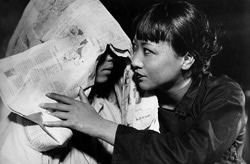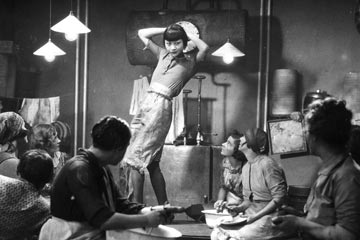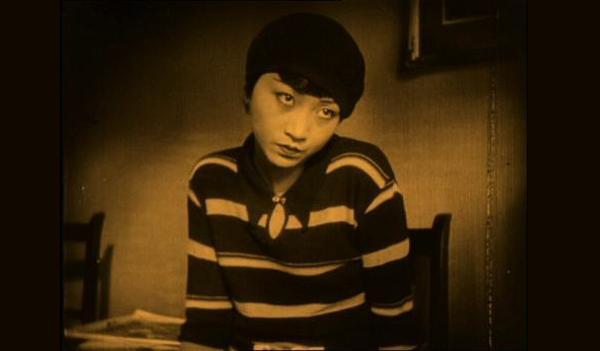 No vision is more uplifting to one suffering a Depression than that of a woman gleefully bursting out of a corset, and the restoration of E.A. Dupont’s PICCADILLY marks a burgeoning of the New Burlesque movement. Since the 90s women film makers, performers and cinema fans have been reviving the world of the burlesque, from Mary Harron and Guinevere Turner’s THE NOTORIOUS BETTIE PAGE to Dita von Teese’s live performances. It is an art form originally contrived to draw the male gaze, and yet to this day has always been very much a focus of dyke chic and womens’ liberation. The women of the The Smoking Cabinet collective facilitate a multi-media celebration of this hitherto forgotten sensation. PICCADILLY stars Anna May Wong whose career follows the burlesque woman’s tightrope strut down the line between empowerment and exploitation.
No vision is more uplifting to one suffering a Depression than that of a woman gleefully bursting out of a corset, and the restoration of E.A. Dupont’s PICCADILLY marks a burgeoning of the New Burlesque movement. Since the 90s women film makers, performers and cinema fans have been reviving the world of the burlesque, from Mary Harron and Guinevere Turner’s THE NOTORIOUS BETTIE PAGE to Dita von Teese’s live performances. It is an art form originally contrived to draw the male gaze, and yet to this day has always been very much a focus of dyke chic and womens’ liberation. The women of the The Smoking Cabinet collective facilitate a multi-media celebration of this hitherto forgotten sensation. PICCADILLY stars Anna May Wong whose career follows the burlesque woman’s tightrope strut down the line between empowerment and exploitation.
An accomplished and incorrigible actress, Wong repeatedly lost leading roles to Caucasian actresses in yellowface. It was Mary Pickford, for instance, who portrayed Madame Butterfly in 1915. Pickford’s husband, the radiantly beautiful Douglas Fairbanks Sr., cast Wong as a Mongol slave in his sorely overlooked Thief of Bagdad in 1924, and it was this brand of stereotype that consistently plagued Wong despite her widely recognised talent and charisma, and her fluency in English and German. Yellowface is a ridiculous branch of mummery which endured at least until the 70s, when Dr Who fell foul of Li Hsen Chang in The Talons of Weng-Chiang. This exemplified the many works of fiction that have perpetuated the myth of Chinese devils adding their opium niff to the London fog in the late 19th century. Rumour swelled the modest population of generally peaceful Limehouse Chinese into a malevolent throng bent on corrupting English maidens. The laundry business could be established even by a poor Chinaman with limited knowledge of the native tongue, which is why they became a cliché of film and music – such as George Formby’s Chinese Limehouse Laundry Blues.
PICCADILLY is swathed in pulp film noir imagery and yet the Chinese scullery maid’s rite of passage depicted in the first two acts follows the Cinderella trope, and so “the kitchen is the kitchen and the scullery is the scullery”. The maid Shosho (played by Wong) at the Piccadilly club must not disrupt the running of the kitchen by dancing on the table. She must not steal a white woman’s lover, especially when the lover is her own employer. And yet she does, and thus the story begins with dirty plate leading to dirty laundry.
With the music turned down, during Shosho’s dance on the kitchen table one imagines the crash and clatter of a kitchen mingled with the echoes of Chinese bells and gongs.
Neil Brand provides the score for Milestone Films’ colour-tinted restoration, and many reviewers objected to his deliberately anachronistic style. It was the film noir aesthetic which appealed to Brand, and he responded to it in the language of jazz. His particular dialect presents as a 21st century renaissance of 80s jazz, which in turn looks back to the 40s. It is very much the composer’s interpretation of character and event. His 7-piece orchestra deliberately patronises and disempowers Gilda Gray and her dancing partner, becoming more reverent as it tracks Shosho’s journey. An eager first-time viewer might prefer to watch the film in silence, or even play their own music of choice, so as to avoid the influence of Brand’s interpretation. Silent movies do, after all, mould themselves to almost any style of music they are paired with, adapting and adjusting willingly to their arranged marriage. With the music turned down, during Shosho’s dance on the kitchen table one imagines the crash and clatter of a kitchen mingled with the echoes of Chinese bells and gongs. Meanwhile upstairs, no music could ever explain the way that Mabel (Gilda Gray) shimmies, like a housewife enjoying a washing machine. Let the viewer synaesthesically hear the shimmy. Shosho’s own dance is sensually amateurish and authentically Chinese – her jittering fingers recalling her adolescent tangle with St Vitus’ Dance, an affliction of the nervous system from which she recovered but clearly remembered the moves.
 The Limehouse Chinese and their vaudeville chums brim with vitality, from the head cook to the ballsy woman caught dancing with a gentleman of colour.
The Limehouse Chinese and their vaudeville chums brim with vitality, from the head cook to the ballsy woman caught dancing with a gentleman of colour.
Gilda Gray’s trademark golden curls lend a resemblance to Harold Gray’s Little Orphan Annie (1924), although in spirit her character more nearly approaches a tired Miss Hannigan who resents little girls. Her statuesque bust and hefty shank are no match for Wong’s lissom and winsome apparition: the international fashion icon makes her second appearance in an outfit that is currently flying from the racks of H&M. She pre-empts the 21st century mingling of 80s and 20s fashion which has planted Louise Brooks/Minnie Mouse hybrids on bar stools throughout contemporary Soho and indeed Chinatown. Going by the phonetically spelled Cockney comments of Shosho’s companion Jim, he and she were born or at least bred in London. And yet their authentically yellow faces betray their heritage, an exotic trait potentially lucrative to Valentine, the owner of the Piccadilly Club.
PICCADILLY’s bold challenging of 20s taboo, and its exultation in good old-fashioned feminine wiles makes it a jewel in the crown of New Burlesque.
The Limehouse Chinese and their vaudeville chums brim with vitality, from the head cook to the ballsy woman caught dancing with a gentleman of colour. This last scene is tinted yellow, and yet the tipsy reveller is clearly turning the air blue… if only the subtitles were not so few and far between. Much can be left to the imagination, and yet only a proficient lip-reader will truly feel the colour. Ironically, for the most part the English characters are as inscrutable as a Chinaman is said to be – and yet with the slightest glare or gesture, Wong tumbles out of the screen and into our arms. Her warmth, determination and anger have an authenticity that can be well understood once her origin and professional struggle are discovered. In real life as well as on screen, she must seduce the white man in defiance of his moral upbringing, and Shosho rolls her sleeves up and does just that. She boldly negotiates her salary with Valentine, and declines to model her costume for him – the long-suffering Jim does the honours without question. The relationship between Shosho and Jim is simple and yet ambiguous, reflecting the complexity of a relationship between a vamp and her admirers.
The cinematography is often febrile and yet never indulgent. A tracking shot guides us down the bar at Shosho’s favourite nightspot, angled at drink-level. It floats past hands of all colours grasping fat jars of ale and comes to rest on Valentine’s English mitt daring to clasp Shosho’s hard little catclaws. During certain dramatic moments in later acts, a bizarre and intricate shadow will tattoo itself across a performer’s face, shadowy props will clutter the edges of a shot, or a woman at a pub window peers through the “oo” in “Saloon”. Shosho’s “come into my parlour” seduction scene features the trained fly from Once Upon A Time In The West – or was it an accidental addition to the list of delightful visual conceits?
PICCADILLY’s bold challenging of 20s taboo, and its exultation in good old-fashioned feminine wiles makes it a jewel in the crown of New Burlesque. Wong and her torch-bearers are here to inspire all victims of social oppression to take their first step on the journey from scatty Mongol slave to a Burlesque force of nature who can, without moving a muscle, have even the coldest Briton lustfully fingering the crease in his fedora.
This article originally appeared in Vertigo Magazine in January 2009.

